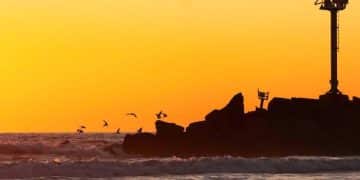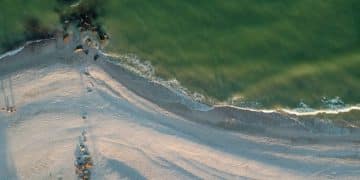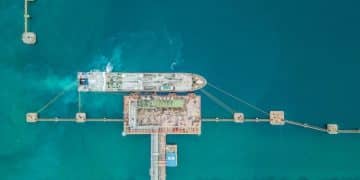US Coastal Resilience: Preparing for Rising Seas & Marine Impact
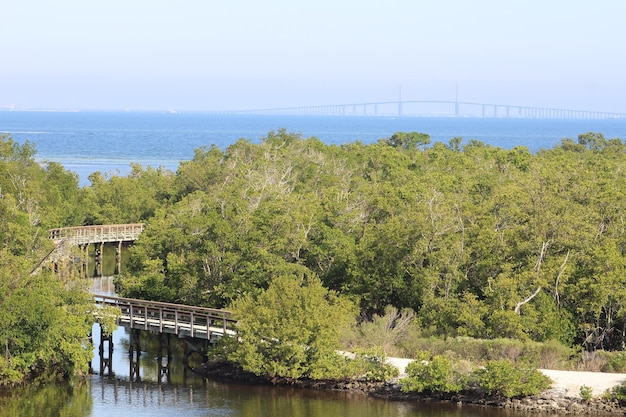
Coastal communities across the US face urgent challenges from rising sea levels, necessitating comprehensive, multi-faceted strategies that integrate infrastructure upgrades, ecosystem restoration, and policy adaptations to safeguard both human habitats and critical marine biodiversity.
How Can Coastal Communities in the US Prepare for Rising Sea Levels and Their Impact on Marine Ecosystems? The question resonates with increasing urgency across the United States. From the bustling harbors of the Northeast to the serene shores of the Gulf Coast, the encroaching tides are no longer a distant threat but a present reality, reshaping coastlines and challenging the very fabric of human and natural systems.
Understanding the Rising Tide: The Science Behind Sea Level Rise
Sea levels have been on a steady ascent for decades, a phenomenon meticulously tracked by scientists globally. This rise is primarily driven by two critical factors: thermal expansion of ocean water as it warms, and the melting of glaciers and ice sheets, particularly from Greenland and Antarctica. The implications for the United States, with its extensive and densely populated coastlines, are profound, impacting millions of lives and vast ecological zones.
The rate of sea level rise is not uniform globally, nor is its impact felt equally across US coastal regions. Gravitational anomalies, ocean currents, and localized land subsidence play significant roles in how different areas experience this change. For instance, parts of the Gulf Coast and the Mid-Atlantic are experiencing faster rates of relative sea level rise due to land sinking, exacerbating the effects of the global average.
Thermal Expansion: A Warming Ocean’s Response
As the Earth’s atmosphere warms, a significant portion of this excess heat is absorbed by the oceans. Water expands when heated, and this thermal expansion directly contributes to the volumetric increase of the oceans. This process is a major component of observed sea level rise and is expected to continue as global temperatures climb.
- 🌊 Ocean absorption of atmospheric heat directly causes water volume to increase.
- 📈 This expansion contributes significantly to global sea level rise.
- 🌡️ Future warming trends predict continued thermal expansion and higher sea levels.
Glacier and Ice Sheet Melt: Contributions from Frozen Realms
The melting of glaciers and polar ice sheets adds vast quantities of freshwater to the oceans. While mountain glaciers contribute a substantial amount, the massive ice sheets of Greenland and Antarctica hold the greatest potential for significant sea level increases. Monitoring these monumental ice bodies is crucial for predicting future sea level trajectories.
The rate of ice melt is accelerating, driven by both atmospheric warming and warming ocean currents that erode ice from below. This dual assault means that even modest increases in global temperatures can have outsized impacts on sea levels, posing a direct threat to low-lying coastal areas.
In conclusion, a comprehensive understanding of the scientific underpinnings of sea level rise—from thermal expansion to ice melt—is the foundational step for any effective preparation strategy. Acknowledging the varying regional impacts within the US is also key to developing localized, targeted responses that reflect unique vulnerabilities.
Impacts on Coastal Communities: Beyond the Shoreline
The consequences of rising sea levels extend far beyond simple coastal erosion. For US coastal communities, these impacts permeate economic, social, and environmental spheres, threatening infrastructure, livelihoods, and public health. The interaction between human systems and the natural environment creates a complex web of challenges that require integrated solutions.
From increasingly frequent and severe flooding during storm surges to the gradual inundation of freshwater sources, the effects are diverse and far-reaching. Businesses reliant on coastal tourism or fishing face existential threats, while residents grapple with property devaluation and the potential need for relocation.
Threats to Infrastructure and Property
Critical infrastructure such as roads, wastewater treatment plants, power grids, and housing is highly vulnerable to rising waters. Saltwater intrusion can damage buried pipes, compromise electrical systems, and undermine foundations. This not only leads to costly repairs but also disrupts essential services, affecting countless residents and businesses.
- 🚧 Coastal roads and bridges are increasingly susceptible to inundation.
- 💡 Power grids and communication networks face heightened risk of disruption.
- 🏠 Homes and businesses in flood zones experience devaluation and damage.
Economic and Social Repercussions
Coastal economies, often built around tourism, fishing, and shipping, are particularly exposed. Beaches vital to tourism may erode, oyster beds essential for fisheries can be destroyed by salinity changes, and ports might become less accessible. These economic shifts can lead to job losses, population displacement, and increased stress on local government resources.
Socially, the stress of living with recurrent flooding, the uncertainty of future property values, and the potential need to abandon ancestral homes can take a severe toll on community well-being. Disproportionately, lower-income communities and communities of color often bear the brunt of these impacts, lacking the resources to adapt or relocate.
The long-term effects on public health also merit serious consideration. Increased mold in flooded homes, disruptions to healthcare services, and the psychological impact of displacement contribute to a deteriorating quality of life. Understanding these multi-faceted impacts is crucial for crafting holistic preparedness strategies that prioritize community resilience and equity.
Ecological Crisis: Marine Ecosystems Under Stress
The delicate balance of marine ecosystems faces an unprecedented challenge from rising sea levels and associated climate changes. Coastal wetlands, coral reefs, and various nearshore habitats are vital nurseries, feeding grounds, and protective barriers for countless species, including those critical to commercial fisheries. Their degradation has cascading effects throughout the marine food web.
Beyond direct inundation, altered salinity levels, increased water temperatures, and sediment redistribution profoundly impact species survival, reproduction, and migration patterns. The loss of these marine ecosystems not only diminishes biodiversity but also reduces natural defenses against coastal hazards, creating a dangerous feedback loop.
Wetlands and Mangroves: Vanishing Coastal Guardians
Coastal wetlands and mangrove forests serve as natural buffers, absorbing storm surges, filtering pollutants, and providing essential habitats. As sea levels rise, these ecosystems struggle to migrate inland if blocked by development, leading to their “coastal squeeze” and subsequent loss. Their disappearance increases coastal communities’ vulnerability to flooding and erosion.
- 🌿 Wetlands filter water and provide vital habitats for marine life.
- 🌳 Mangroves protect shorelines from erosion and storm impacts.
- 📉 Their loss amplifies coastal vulnerability and biodiversity decline.
Coral Reefs: Bleaching and Habitat Loss
Coral reefs, often called the “rainforests of the sea,” are highly sensitive to changes in water temperature and acidity. Rising sea levels can exacerbate other stressors, such as ocean acidification and warming, leading to coral bleaching events and reducing light penetration essential for their survival. Degraded reefs offer less protection from waves, further eroding coastlines.
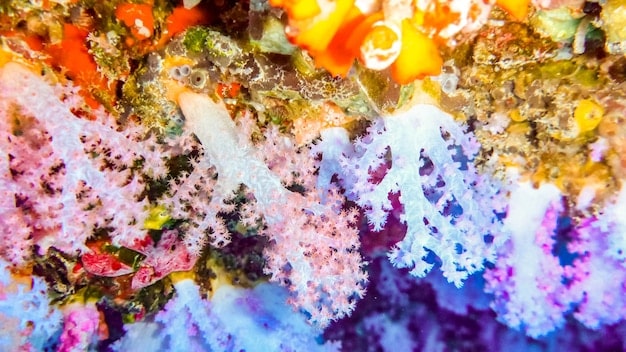
The health of coral reefs is intrinsically linked to the health of marine biodiversity. Many fish species rely on reefs for shelter, food, and breeding grounds. The decline of these vital ecosystems not only impacts the marine food web but also has severe economic repercussions for communities relying on fisheries and tourism.
In summary, safeguarding marine ecosystems is not merely an environmental imperative but a crucial component of coastal community resilience. Integrating ecosystem protection and restoration into adaptation strategies is essential for preserving both ecological services and human well-being.
Adaptation Strategies: Hard vs. Soft Approaches
Facing the undeniable reality of rising sea levels, coastal communities have two broad categories of adaptation strategies: hard or engineered solutions and soft or nature-based solutions. Each approach offers distinct advantages and disadvantages, and the most effective strategies often involve a thoughtful combination tailored to specific local conditions and community preferences.
Hard solutions typically involve constructing physical barriers, while soft solutions leverage natural processes and ecosystems. Deciding which path, or combination, to take requires careful consideration of costs, long-term effectiveness, environmental impacts, and community acceptance.
Hard Engineering Solutions: Building Defenses
Traditional “hard” engineering approaches focus on controlling water with physical structures. These include seawalls, levees, dikes, and breakwaters, designed to prevent water from reaching developed areas. While offering immediate protection, they can be costly to build and maintain, may alter natural coastal processes, and can sometimes accelerate erosion in adjacent areas.
In some cases, hard infrastructure is indispensable, particularly in densely populated urban areas where retreat is not feasible. The challenge lies in integrating these structures in a way that minimizes negative environmental consequences and provides long-term, sustainable protection.
- 🧱 Seawalls and dikes offer direct protection against storm surges.
- 🚧 These structures can be expensive and may lead to “coastal squeeze.”
- 🌍 Their implementation often requires careful environmental impact assessments.
Soft or Nature-Based Solutions: Working with Nature
Nature-based solutions harness and enhance natural coastal features to provide protection. Examples include restoring mangroves, wetlands, and oyster reefs, beach nourishment (replenishing sand), and creating living shorelines. These approaches are often more cost-effective in the long run, provide additional ecological benefits, and can adapt more flexibly to changing conditions.
For instance, healthy salt marshes can attenuate wave energy, reduce erosion, and also serve as vital bird habitats and carbon sinks. Living shorelines, which use natural materials like plants and shells, blend into the landscape and contribute to healthy ecosystems, offering a more resilient and often more aesthetically pleasing solution than a concrete wall.
The strategic planning for adaptation must consider the unique characteristics of each coastline, the available resources, and the desires of the local community. A blend of hard and soft approaches, often referred to as “hybrid solutions,” frequently offers the most comprehensive and sustainable path forward, combining the robustness of engineered structures with the ecological benefits of natural systems.
Policy and Planning: Governance for Resilience
Effective preparation for rising sea levels requires robust policy and proactive planning at all levels of governance—local, state, and federal. These frameworks must guide development, allocate resources, and foster collaboration across diverse stakeholders. Without clear policy directives and comprehensive plans, adaptation efforts risk being fragmented, inefficient, and ultimately insufficient.
The challenge lies in moving beyond reactive measures to implement forward-looking strategies that account for long-term projections of sea level rise. This often involves difficult conversations about land use, building codes, and financial incentives for resilient development.
Zoning and Building Codes: Shaping Future Development
Local zoning ordinances and building codes are powerful tools for managing coastal risk. Updating these to account for future flooding scenarios can prevent new construction in high-risk areas, encourage elevated structures, and ensure that new and existing buildings are more resilient to water intrusion. Permitting processes can also be adjusted to incentivize green infrastructure and discourage hard defenses where soft solutions are more appropriate.
- 🏗️ New building codes can mandate elevated foundations and flood-resistant materials.
- 🚫 Zoning regulations can restrict development in increasingly vulnerable areas.
- 📊 Incentives can encourage resilient practices and discourage risky construction.
Funding Mechanisms and Economic Incentives
Implementing large-scale adaptation projects requires significant financial investment. Governments can establish dedicated funding streams, create bond programs, or explore innovative public-private partnerships. Economic incentives, such as grants for homeowners to elevate their properties or tax breaks for developers building resilient infrastructure, can accelerate adaptation efforts.
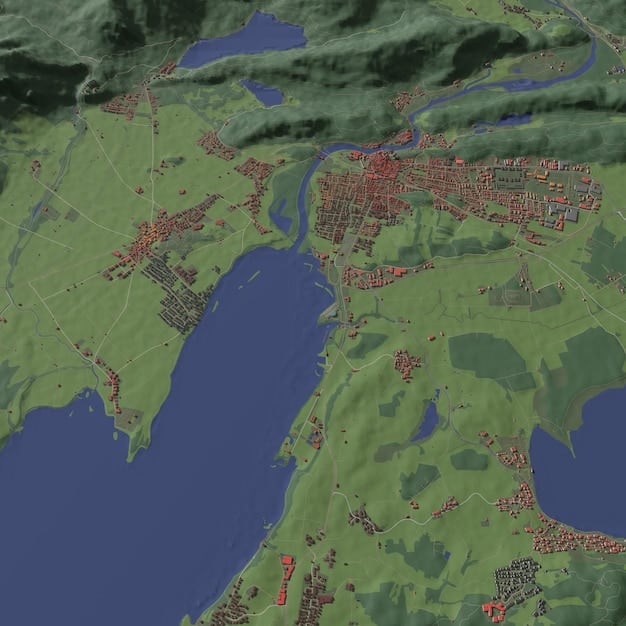
Additionally, integrating climate change considerations into insurance policies can help signal risk and encourage mitigation. Subsidized flood insurance rates, for example, can inadvertently incentivize construction in high-risk zones, whereas actuarially sound rates would better reflect the true cost of risk, prompting more resilient choices.
Ultimately, effective policy and planning establish the framework within which adaptation can occur. This includes not only regulatory tools but also financial mechanisms and robust community engagement processes. Foresight, flexibility, and a willingness to make tough decisions are paramount for resilient coastal governance.
Community Engagement and Education: Empowering Resilience
Successful adaptation to rising sea levels is not solely a top-down endeavor; it critically depends on robust community engagement and widespread education. Local residents, businesses, and community leaders are directly impacted and possess invaluable local knowledge. Empowering them with information and involving them in decision-making processes fosters a sense of ownership and ensures that solutions are culturally appropriate and widely supported.
Educating the public about the science of sea level rise, its specific local impacts, and potential adaptation strategies is the first step. This understanding helps dispel misconceptions, build consensus, and mobilize collective action. Effective communication transcends complex scientific jargon, translating it into actionable insights.
Building Local Knowledge and Capacity
Coastal communities often have deep historical and ecological knowledge that is crucial for effective planning. Engaging local fishermen, indigenous communities, and long-term residents can provide insights into historical flood patterns, local ecosystem dynamics, and traditional adaptation practices. Workshops, public forums, and citizen science initiatives can co-produce knowledge and build local capacity for resilience.
- 🗣️ Public forums facilitate open discussions and community input.
- 📚 Educational workshops demystify climate science and adaptation options.
- 🤝 Citizen science programs enable residents to contribute to data collection.
Fostering a Culture of Preparedness
Beyond understanding, communities need to develop a culture of preparedness. This involves regular communication about flood risks, promoting individual and household-level mitigation measures (like elevating utilities), and establishing clear evacuation plans and emergency response protocols. Local leaders, non-profits, and educational institutions play a vital role in disseminating this information and fostering readiness.
This cultural shift extends to encouraging resilient architecture and landscaping choices. When individual property owners understand the benefits of elevating their homes, opting for native, salt-tolerant landscaping, or installing permeable surfaces, the collective resilience of the community significantly increases. Empowered communities are more likely to support and participate in broader adaptation initiatives, leading to more sustainable and equitable outcomes.
In essence, community engagement and education are the connective tissue that links scientific understanding, policy development, and on-the-ground implementation. By prioritizing these elements, coastal communities can build not only physical resilience but also the social cohesion necessary to navigate the challenges of a changing climate.
Innovative Solutions and Future Outlook
As the challenges posed by rising sea levels persist, innovation continues to be a driving force in developing more effective and sustainable solutions. Beyond traditional hard and soft engineering, new technologies, scientific advancements, and interdisciplinary approaches are emerging to enhance coastal resilience. The future of coastal protection lies in embracing these innovations and adapting our strategies to a dynamic environment.
This includes advances in forecasting, materials science, and ecological engineering, all aimed at protecting communities and marine ecosystems more effectively and adaptively. The outlook is not one of resignation but of determined ingenuity, seeking ways to coexist and thrive with a changing ocean.
Advanced Monitoring and Predictive Modeling
Improvements in satellite technology, sensor networks, and computational modeling are revolutionizing our ability to monitor sea level changes and predict their impacts with greater precision. This enhanced data allows communities to make more informed decisions about land use, infrastructure investments, and emergency preparedness. Real-time flood mapping and early warning systems can save lives and minimize property damage.
- 🛰️ Satellite data provides precise measurements of sea level rise.
- 💻 Predictive models forecast future inundation scenarios and their impacts.
- 🚨 Early warning systems enhance community safety and emergency response.
Blue Carbon Initiatives and Aquaculture
“Blue carbon” ecosystems, such as mangroves, salt marshes, and seagrass beds, are highly effective at sequestering atmospheric carbon dioxide, offering a dual benefit of climate change mitigation and coastal protection. Investing in the restoration and preservation of these habitats can provide natural defenses while also combating global warming.
Innovative aquaculture practices can also play a role in resilience, supporting oyster reefs for natural breakwaters or cultivating seaweed to absorb excess nutrients. These nature-based solutions often integrate ecological benefits with economic opportunities, creating more holistic and sustainable coastal management strategies.
The future outlook for US coastal communities grappling with rising sea levels is one that emphasizes integrated, adaptive, and innovative approaches. Successful preparation will involve a continuous process of learning, adjusting, and investing in solutions that protect both human populations and the invaluable marine ecosystems they depend upon. The goal is to build resilience—not just to survive, but to thrive in a changing world.
| Key Area | Brief Description |
|---|---|
| 🚢 Infrastructure Resilience | Elevating structures, building sea walls, and improving drainage to protect urban areas. |
| 🌱 Ecosystem Restoration | Restoring mangroves, wetlands, and oyster reefs for natural protection and habitat. |
| 🏛️ Policy & Planning | Implementing updated zoning laws, building codes, and securing funding for adaptation. |
| 🗣️ Community Engagement | Educating and involving local residents in developing and implementing resilience plans. |
Frequently Asked Questions About Coastal Resilience
▼
The two main drivers are the thermal expansion of ocean water as it warms and the melting of glaciers and ice sheets, particularly from Greenland and Antarctica. Local factors such as land subsidence and ocean currents can also significantly influence regional rates of sea level rise in the US, making some areas more vulnerable than others to the same global trends.
▼
Rising sea levels lead to increased flooding, saltwater intrusion, and erosion, which can damage critical infrastructure like roads, bridges, wastewater treatment plants, and power grids. This damage results in costly repairs, service disruptions, and can shorten the lifespan of essential public and private assets, posing significant economic challenges for coastal communities.
▼
Nature-based solutions involve harnessing natural processes and ecosystems to protect coastlines. Examples include restoring mangroves, salt marshes, and oyster reefs, which act as natural buffers against storm surges and erosion. These methods are often more cost-effective, provide ecological benefits, and can adapt more flexibly to changing environmental conditions compared to hard engineering.
▼
Community involvement is crucial because local residents possess invaluable knowledge about their specific coastline and are directly affected by changes. Engaging them in planning and decision-making fosters support for adaptation strategies, ensures solutions are tailored to local needs, and builds a collective culture of preparedness, leading to more resilient and equitable outcomes for all.
▼
Absolutely. Robust policies and updated zoning laws can guide future development away from high-risk areas, mandate resilient building practices, and incentivize property elevation. They provide the necessary framework for resource allocation and coordinated efforts across different governmental levels, ensuring that communities are not just reacting to sea level rise but proactively planning for long-term adaptation.
Conclusion
The imperative for US coastal communities to prepare for rising sea levels and their profound impact on marine ecosystems has never been clearer. This complex challenge demands a holistic approach, integrating scientific understanding with innovative engineering, sound policy, and empowered community engagement. By balancing hard infrastructure with nature-based solutions, enacting forward-thinking regulations, and fostering a deep sense of collective responsibility, these communities can build resilience. The journey towards a more secure coastal future is multifaceted, but by embracing adaptive strategies and valuing our invaluable marine environments, we can navigate these changes, ensuring safety, sustainability, and a symbiotic relationship between human life and the ocean.

